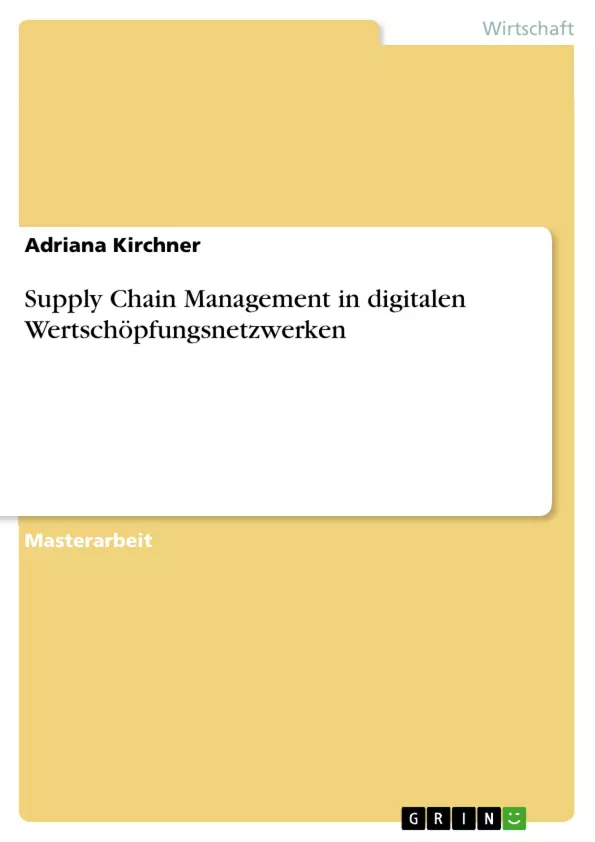Thema der nachfolgenden Arbeit ist die ganzheitliche Betrachtung des Supply Chain Managements (SCM) in Wissenschaft und Praxis sowie der konzeptionellen und technischen Aspekte des Supply Chain Event Managements (SCEM). Beleuchtet werden die Besonderheiten und Gesetzmäßigkeiten des SCEM und der Aufgabe von neuen digitalen Formen des Tracking & Tracing (T&T).
Die Arbeit gliedert sich in drei Teilbereiche. Im ersten Schritt wird die Begrifflichkeit SCM näher erörtert und sowohl auf Konzeption als auch auf Gestaltung und Steuerung von Supply Chains eingegangen. In Folge wird ein besonderes Augenmerk auf die Rolle der Informations- und Kommunikationstechnologie im SCM, allem voran des T&T gelegt.
Im zweiten Schritt widmet sich die Arbeit dem SCEM, seiner Definition und der Rolle von T&T als Steuerungselement im SCEM.
Im dritten Bereich wird versucht, die Verbreitung von SCM und SCEM sowie Einflussfaktoren, mit besonderem Fokus auf der Rolle von T&T, empirisch zu erforschen. Hierbei wird sowohl auf das Instrument der Online-Umfrage als auch auf Experteninterviews zurückgegriffen. Die Online-Umfrage soll den aktuellen Status von SCM und SCEM in Unternehmen erheben. Anhand von Experteninterviews soll vor allem das State of the Art von SCM und SCEM in unterschiedlichen Branchen und Unternehmensgrößen erforscht werden.
Inhaltsverzeichnis
- 1. Supply Chain Management (SCM)
- 1.1. Problemstellung
- 1.2. Zielsetzung und Forschungsfragen
- 1.3. Aufbau der Arbeit
- 1.4. Methodisches Vorgehen
- 2. Supply Chain Management (SCM)
- 2.1. Definition von SCM
- 2.2. Digitale Wertschöpfungsketten und -netzwerke
- 2.3. Konzeption von Supply Chains
- 2.3.1. Strategisches SCM
- 2.3.2. Operatives SCM
- 2.4. Gestaltung von Supply Chains
- 2.4.1. Das Supply-Chain-Operations-Referenz-Modell (SCOR)
- 2.4.2. SCM-Aufgabenmodell und die Einordnung von Tracking & Tracing
- 2.5. SCM und Besonderheiten ausgewählter Branchen
- 2.5.1. SCM in der pharmazeutischen Industrie
- 2.5.2. SCM in der chemischen Industrie
- 2.5.3. SCM in der Lebensmittelindustrie
- 2.5.4. SCM in der Automobilindustrie
- 2.6. Steuerung von Supply Chains
- 2.6.1. Steuerung im Unternehmenskontext
- 2.6.2. Steuerung im Netzwerk Kontext
- 2.6.3. Supply Chain Performance Management (SCPM)
- 2.7. Die Rolle der Informations- und Kommunikationstechnologie (IKT)
- 2.7.1. Bezugsrahmen Produktion und Distribution
- 2.7.2. Prozessübergreifender Bezugsrahmen
- 2.7.3. Big Data und Künstliche Intelligenz (KI)
- 3. Supply Chain Event Management (SCEM)
- 3.1. Definition von SCEM
- 3.2. Tracking & Tracing (T&T)
- 3.2.1. T&T-Ausprägungsformen
- 3.2.2. T&T in der Praxis
- 3.2.3. Störfaktoren in der SC und SC Resilienz
- 3.3. Möglichkeiten zur Umsetzung von selbststeuernder SCEM Software
- 3.3.1. Einordnung des SCEM in das SCM Konzept
- 3.3.2. SCEM Software – Treiber und Kernfunktionen
- 3.3.3. SCEM Konzeption und Selbststeuerung
- 3.4. Anbieter von SCEM Software
- 3.5. T&T als Steuerungselement im SCEM
- 3.5.1. T&T im SCEM unter dem Aspekt Wirtschaftlichkeit
- 3.5.2. T&T im SCEM unter dem Aspekt Risikomanagement
- 3.5.3. Wertbeitrag des T&T zur Aufrechterhaltung von Lieferketten
- 4. Empirische Untersuchung zu SCM, SCEM und Tracking & Tracing: Online-Umfrage und Experteninterviews
- 4.1. Online-Umfrage
- 4.1.1. Begründung der Methodenwahl
- 4.1.2. Erstellung des Fragenkatalogs und Auswahl der Stichprobe
- 4.1.3. Auswertung der Ergebnisse
- 4.2. Experteninterviews
- 4.2.1. Begründung der Methodenwahl
- 4.2.2. Auswahl der Experten
- 4.2.3. Durchführung der Untersuchungen
- 4.2.4. Auswertung der Ergebnisse
- 4.3. Diskussion der Ergebnisse
- 5. Zusammenfassung
- 6. Literaturverzeichnis
- 6.1. Bücher, Journale und Studien
- 6.2. Online-Quellen
- 7. Abbildungsverzeichnis
- 8. Tabellenverzeichnis
- 9. Abkürzungsverzeichnis
- 10. Experten
- 11. Interviews
- 11.1. Experte 1 (E1)
- 11.2. Experte 2 (E2)
- 11.3. Experte 3 (E3)
- 11.4. Experte 4 (E4)
- 11.5. Experte 5 (E5)
- 11.6. Experte 6 (E6)
- 11.7. Experte 7 (E7)
- 11.8. Experte 8 (E8)
- 11.9. Experte 9 (E9)
- 11.10. Experte 10 (E10)
- 11.11. Experte 11 (E11)
- 11.12. Experte 12 (E12)
- 11.13. Experte 13 (E13)
- 11.14. Experte 14 (E14)
- 11.15. Experte 15 (E15)
- 11.16. Experte 16 (E16)
- 12. Anlagen
Zielsetzung und Themenschwerpunkte
Ziel dieser Arbeit ist die ganzheitliche Betrachtung des Supply Chain Managements (SCM) in Wissenschaft und Praxis sowie die konzeptionellen und technischen Aspekte des Supply Chain Event Managements (SCEM). Besonderes Augenmerk liegt auf den Besonderheiten und Gesetzmäßigkeiten des SCEM und der Aufgabe neuer digitaler Formen des Trackings & Tracings (T&T).
- Analyse von SCM-Konzepten und deren Anwendung in verschiedenen Branchen
- Untersuchung der Rolle von IKT und T&T im SCM und SCEM
- Empirische Erforschung der Verbreitung und des Einflusses von SCEM und T&T
- Identifikation von Erfolgsfaktoren und Hindernissen bei der Implementierung von SCEM
- Bewertung des Entwicklungspotenzials von SCEM und T&T
Zusammenfassung der Kapitel
(Kapitelzusammenfassungen ohne Schlussfolgerungen oder Spoiler würden hier folgen. Jede Zusammenfassung sollte sich auf die Hauptthemen und Argumente des jeweiligen Kapitels konzentrieren und einen konsistenten Detaillierungsgrad aufweisen.)
Schlüsselwörter
Supply Chain Management (SCM), Supply Chain Event Management (SCEM), Tracking & Tracing (T&T), Informations- und Kommunikationstechnologie (IKT), Digitale Wertschöpfungsketten, Big Data, Künstliche Intelligenz (KI), Resilienz, Wirtschaftlichkeit, Lieferantenmanagement, Konzerne, KMU, Pharmaindustrie, Chemieindustrie, Lebensmittelindustrie, Automobilindustrie, Just-in-Time, Just-in-Sequence, VMI, EDI, Blockchain Technologie, Globalisierung, Digitalisierung.
- Quote paper
- MBA Adriana Kirchner (Author), 2022, Supply Chain Management in digitalen Wertschöpfungsnetzwerken, Munich, GRIN Verlag, https://www.grin.com/document/1505797



